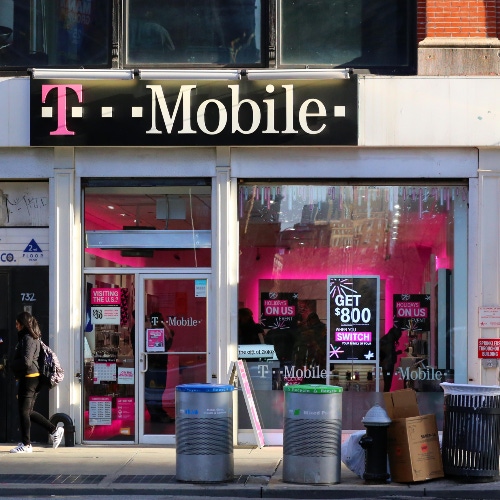T-Mobile is reportedly working with Citigroup to find partners to invest up to $4 billion to build a fiber network, an effort that could reach up to 4 million homes.

T-Mobile is reportedly working with Citigroup to find partners to invest up to $4 billion to build a fiber network in unspecified parts of the US. T-Mobile is the nation's second biggest wireless network operator, in terms of subscribers, but it is the only big mobile provider that doesn't own a wired network.
The news – from Bloomberg, citing unnamed sources familiar with the matter – dovetails with a recent report, also from Bloomberg, that AT&T is talking to infrastructure investors about expanding its massive fiber network buildout even further. According to that report, AT&T has hired Morgan Stanley to help drive interest among investors for a fiber joint venture worth up to $15 billion.
AT&T, for its part, has already committed to doubling its fiber footprint to around 30 million locations by 2025 by upgrading its aging DSL network. But the company has already signaled ambitions beyond that; for example, it is building a fiber network in the Phoenix, Arizona, suburb of Mesa, a location beyond the boundaries of its existing copper network footprint.
T-Mobile toys with fiber
"We are very open minded about whether our team, our ability to execute, our brand, our in-place 5G network, could serve broader markets," T-Mobile CEO Mike Sievert said recently when questioned about his company's interest in building fiber.
Figure 1:  (Source: Robert K. Chin - Storefronts/Alamy Stock Photo)
(Source: Robert K. Chin - Storefronts/Alamy Stock Photo)
"And so we're of course interested in adjacencies that would very smartly utilize all of those assets, including our physical and digital distribution capabilities. And so we're interested," he continued. Sievert made his comments during T-Mobile's recent quarterly conference call, according to a Seeking Alpha transcript. "We haven't drawn any conclusions about it and I really can't answer whether 5G fixed wireless success makes us more interested or less interested. It could be a little of both for the obvious reasons. So you'll have to stay tuned. We're having a look at it."
T-Mobile last year dipped its toe into the fiber-to-the-home market in Manhattan by quietly introducing T-Mobile Fiber. According to the financial analysts at New Street Research, the company partnered with Pilot Fiber to sell 950 Mbit/s connections, and is currently covering 700 buildings with the service.
T-Mobile officials have described the offering as a test in order to discover whether the company can also offer fiber in addition to fixed wireless access (FWA) and smartphone services. "We'll look at those things. And we haven't drawn any conclusions," Sievert said of the test.
Of course, T-Mobile's existing 5G network sits atop nationwide fiber networks operated by other companies; T-Mobile leases connections on those networks to route its customers' traffic across the country and the world. But T-Mobile officials have argued that those leases are relatively inexpensive. Indeed, T-Mobile recently unloaded its legacy Sprint wireline business, striking a deal to sell the asset to Cogent in a transaction valued at $1.
According to the New Street analysts, T-Mobile could cover between 1 million and 4 million homes with a $4 billion fiber effort, depending on whether it pursues government subsidies or not. The analysts also speculated that T-Mobile could potentially partner with an existing fiber provider like Frontier.
A growing frenzy
T-Mobile's reported interest in fiber comes as little surprise. AT&T, Frontier, Altice, Lumen Technologies, Shentel and a wide range of other US telecom operators are in various stages of building out new fiber networks around the country.
And looming over the industry are billions of dollars in federal subsidies intended to help construct fiber networks in rural areas, and to help low-income Americans afford speedy Internet connections.
T-Mobile officials have suggested that the company's 5G-powered FWA service could be eligible for such subsidies, but federal authorities have expressed a clear desire to funnel funds to fiber first.
"We have argued for some time that in the long-run T-Mobile (and others) will need a terrestrial network," wrote the New Street analysts in a note to investors this week in response to the new Bloomberg article. They wrote that T-Mobile will need a wireline network of some kind in order to build out its millimeter wave (mmWave) spectrum holdings, in part to expand its FWA effort, at some point in the future.
If T-Mobile were to build a fiber network, it would join the likes of Verizon, AT&T and Comcast in owning both wireless and wired network elements. Indeed, such companies have trumpeted their ability to combine those operations in innovative ways.
"The opportunity that we have going forward is to integrate wireless services – mobility, cellular service – into overall wireline connectivity and to sell that in a way that reduces customers bills and causes us to have a better product and a better price than our competitors, and a package for consumers that they can't really replicate anywhere else," Tom Rutledge, Charter Communications' outgoing CEO, recently told CNBC.
Indeed, Charter recently introduced a wireless/wireline bundle called "SpectrumOne."
However, investors' appetite for new fiber initiatives – even from Wall Street sweetheart T-Mobile – may be difficult to find. For example, a group of banks recently canceled efforts to sell $3.9 billion of debt intended to finance Apollo Global Management's deal to buy telecom assets from Lumen Technologies.
Related posts:
— Mike Dano, Editorial Director, 5G & Mobile Strategies, Light Reading | @mikeddano
About the Author(s)
You May Also Like











